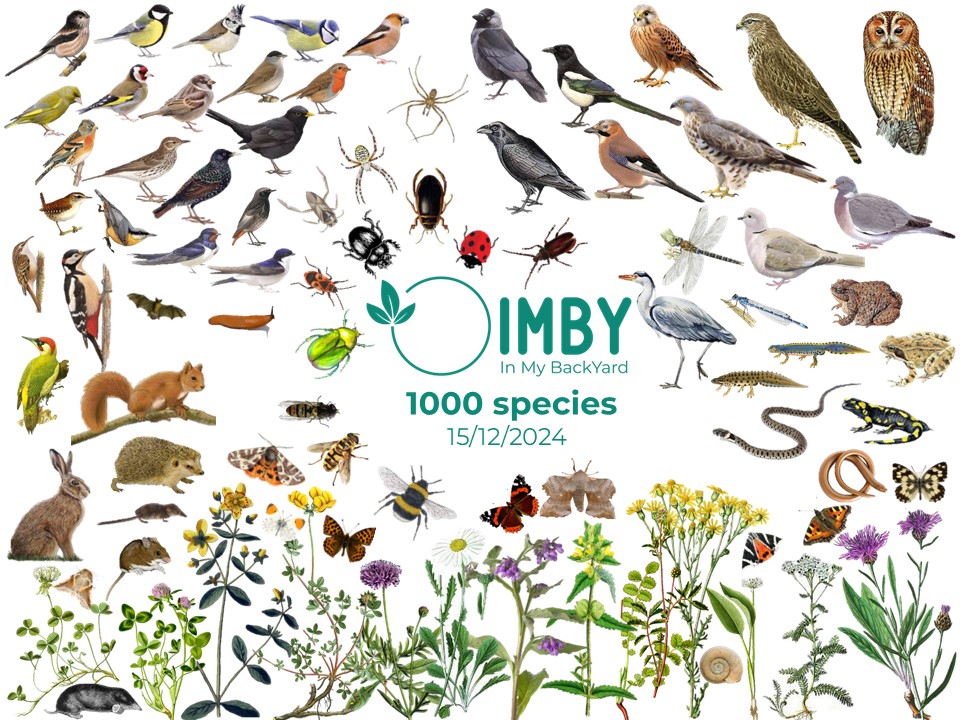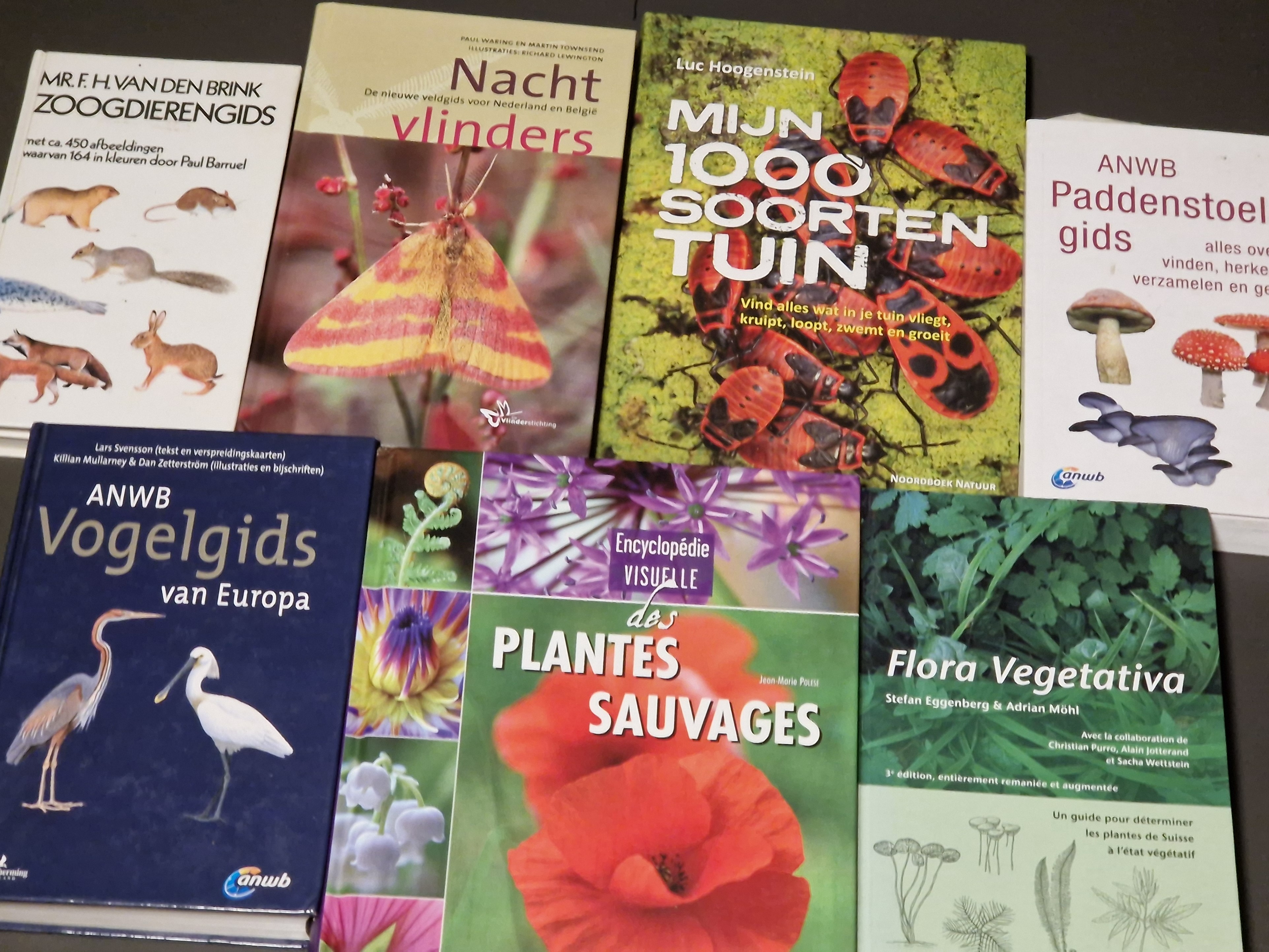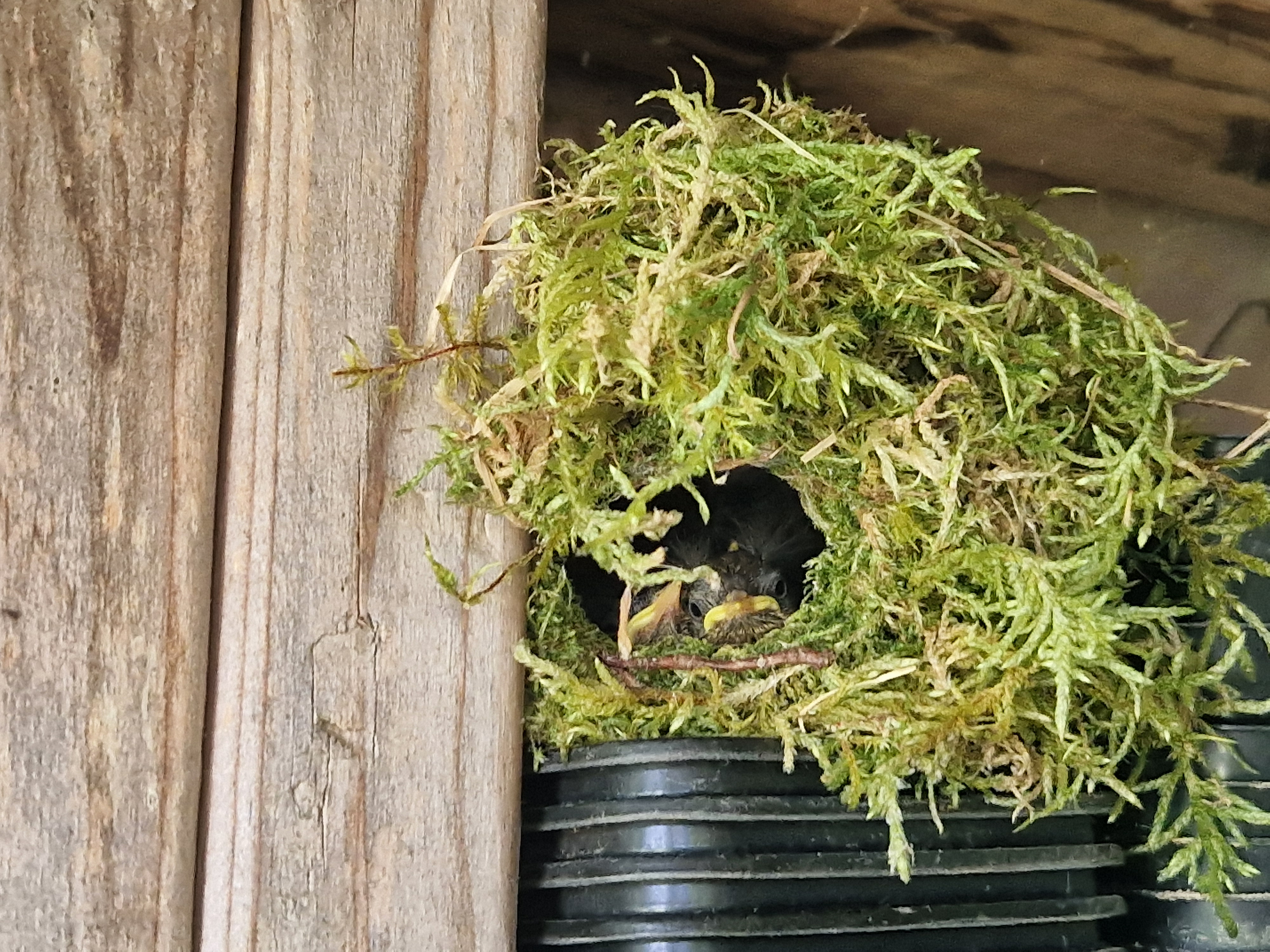
.jpg)

.jpg)

Our 1000-species garden !
15/12/2024
As a biologist, I have always been interested in everything that jumps, flies, crawls, swims, flutters and hums. In recent years, the plant kingdom has been of particular interest to me, especially since a multitude of native plants attracts a wealth of animal species. When we moved to our place in the Condroz in 2020, our garden was a tight lawn with a few fruit trees. On the west side, the garden is bordered by a beautiful old Ferraris beech forest, and at the back it borders a meadow with beautiful far views.
Shortly after our move, we started making plans to transform our garden into a little oasis for ourselves and the local biodiversity. A pond was dug and some 350 native shrubs were planted as mixed hedge bushes. The neat lawn was first transformed into long grass with mowed grass paths and now several years later we enjoy a flower meadow. Frank brought our abandoned vegetable garden to live with both vegetables and flowers and we planted about 20 berry bushes, two high stemmed fruit trees and a walnut tree.
Initially, I was mainly interested in the 'big' mammals of the nearby forest, the local 'big five' so to speak, being wild boar, roe deer, fox, badger and wild cat. In winter, I observed the birds at the feeders: the great spotted woodpecker, goldfinch, hawfinch and nuthatch remain favourites. In spring, I tried to identify butterflies, dragonflies and damselflies. Meanwhile, I kept a log of all the plant species we planted or sowed ourselves, in addition to identified wildflowers that emerged spontaneously from the seed bank. The beginnings of a species list had been started. No longer just the big, cuddly species, but also smaller species and plants.
The planting caught on and grew bigger and stronger every year. We mastered the mowing of our meadow and the diversity of wildflowers increases every year. The pond has become an explosion of life where it is good to be. I became more and more intrigued by all that diversity. Binoculars, a moth trap, a scoop net, four wildlife cameras and a magnifying glass kept me busy documenting all that beauty. A stack of identification guides and especially the wonderful app 'obsidentify' helped identify the species. The species list got longer and longer ...
One day I heard about 'the 1000-species garden' and a group of enthusiastic nature lovers who name and list all the 'organisms' in their gardens with the ultimate goal of arriving at a list of 1000 species and sometimes even more. There were also people included with a small city garden. So I felt we could do this as well. It became my new challenge and hobby.
It turned out to be a great adventure with many moments of joy, here are some of my memorable highlights:
A follower and naturalist who took up the same challenge made this nice comment on a previous post: 'At 500 species it seems hard to add more to your list, but at 1000 you realise that far from everything has been documented!' This is absolutely true and so I still have a long way to go. My next investment will be a microscope to dive all the way into the microcosm.
Real diehards may frown at my list: some flies are not yet identified at species level, I count both wild plants, but also those I have sown and planted - and thus introduced - myself. The vast majority are native species but there are some cultivars that were already here. You can be very strict about what you count or not, that's as you wish. In the end, it's not about the number 1000, but rather the discovery trail. A true pleasure and positive experience. A stroll in the garden with the dog now becomes an hour of wonder. In times when nature and our biodiversity are not doing so well, it gives satisfaction and hope to know that where you design green spaces naturally, nature does manage to win its place. Garden by garden, we can indeed make a difference.
The burning question on everyone's lips, of course, is: what was the 1000th species? Well, a common native mushroom with the name 'scurfy twiglet', aka Tubaria furfuracea that lives off dead organic material. I just found this specimen at the bottom of our mixed hedge. In itself nothing special and yet very valuable in the mini-ecosystem that is our garden, because each species counts and is part of the food web. I have the feeling that in terms of mushrooms there is still a lot of potential and I want to look into it. Fauna, flora but also fungi!
If you too would like to get started with a 1000-species garden or just welcome more nature in your garden, keep following us. In the new year, we will offer a free webinar full of tips for biodiversity-friendly and natural gardens. Or if you want to come and take a look in our backyard, you can do that too. On 7-8 June 2025, we will participate in the Velt ecogarden days. Everyone is welcome to the Condroz! Until then happy end-of-year celebrations to all and we wish you an even greener 2025!
Shortly after our move, we started making plans to transform our garden into a little oasis for ourselves and the local biodiversity. A pond was dug and some 350 native shrubs were planted as mixed hedge bushes. The neat lawn was first transformed into long grass with mowed grass paths and now several years later we enjoy a flower meadow. Frank brought our abandoned vegetable garden to live with both vegetables and flowers and we planted about 20 berry bushes, two high stemmed fruit trees and a walnut tree.
Initially, I was mainly interested in the 'big' mammals of the nearby forest, the local 'big five' so to speak, being wild boar, roe deer, fox, badger and wild cat. In winter, I observed the birds at the feeders: the great spotted woodpecker, goldfinch, hawfinch and nuthatch remain favourites. In spring, I tried to identify butterflies, dragonflies and damselflies. Meanwhile, I kept a log of all the plant species we planted or sowed ourselves, in addition to identified wildflowers that emerged spontaneously from the seed bank. The beginnings of a species list had been started. No longer just the big, cuddly species, but also smaller species and plants.
The planting caught on and grew bigger and stronger every year. We mastered the mowing of our meadow and the diversity of wildflowers increases every year. The pond has become an explosion of life where it is good to be. I became more and more intrigued by all that diversity. Binoculars, a moth trap, a scoop net, four wildlife cameras and a magnifying glass kept me busy documenting all that beauty. A stack of identification guides and especially the wonderful app 'obsidentify' helped identify the species. The species list got longer and longer ...
One day I heard about 'the 1000-species garden' and a group of enthusiastic nature lovers who name and list all the 'organisms' in their gardens with the ultimate goal of arriving at a list of 1000 species and sometimes even more. There were also people included with a small city garden. So I felt we could do this as well. It became my new challenge and hobby.
It turned out to be a great adventure with many moments of joy, here are some of my memorable highlights:
- A grass-snake (>1m long) hunting in our pool and a year later also 3 little ones
- The simultaneous hatching of some 25 nymphs of emperor dragonfly on the yellow iris in our pond
- The raccoon caught on the camera trap (given its exotic origin, perhaps rather a low point)
- The extraordinary spectacle of metamorphosis of hundreds of June beetles forming clouds around our fruit trees at sunset
- A 20 tiny holes of larvae of spotted antlions in the sand of our garden shed
- The nest of a wren on the plant pots in that same garden shed
- Three common pipistrelle hunting at night over the meadow and pond for 4 years in a row
- Five beautiful old world swallowtail caterpillars on one large dill plant
- Fire salamanders entering the forest edge of our garden during wet autumn night
A follower and naturalist who took up the same challenge made this nice comment on a previous post: 'At 500 species it seems hard to add more to your list, but at 1000 you realise that far from everything has been documented!' This is absolutely true and so I still have a long way to go. My next investment will be a microscope to dive all the way into the microcosm.
Real diehards may frown at my list: some flies are not yet identified at species level, I count both wild plants, but also those I have sown and planted - and thus introduced - myself. The vast majority are native species but there are some cultivars that were already here. You can be very strict about what you count or not, that's as you wish. In the end, it's not about the number 1000, but rather the discovery trail. A true pleasure and positive experience. A stroll in the garden with the dog now becomes an hour of wonder. In times when nature and our biodiversity are not doing so well, it gives satisfaction and hope to know that where you design green spaces naturally, nature does manage to win its place. Garden by garden, we can indeed make a difference.
The burning question on everyone's lips, of course, is: what was the 1000th species? Well, a common native mushroom with the name 'scurfy twiglet', aka Tubaria furfuracea that lives off dead organic material. I just found this specimen at the bottom of our mixed hedge. In itself nothing special and yet very valuable in the mini-ecosystem that is our garden, because each species counts and is part of the food web. I have the feeling that in terms of mushrooms there is still a lot of potential and I want to look into it. Fauna, flora but also fungi!
If you too would like to get started with a 1000-species garden or just welcome more nature in your garden, keep following us. In the new year, we will offer a free webinar full of tips for biodiversity-friendly and natural gardens. Or if you want to come and take a look in our backyard, you can do that too. On 7-8 June 2025, we will participate in the Velt ecogarden days. Everyone is welcome to the Condroz! Until then happy end-of-year celebrations to all and we wish you an even greener 2025!
Comments
- Merci à vous de (re-) créer la vie! (Vincent D.)
- Wat een geweldig verhaal An en Frank! Genieten er echt van te lezen hoe enthousiast jullie ermee bezig zijn. Onze ambitie is lager gespannen maar toch vinden we bij jullie inspiratie om ook meer aandacht te hebben voor de prachtige biodiversiteit in onze eigen nabije omgeving. We weten het zeker, ook jullie zijn nog lang niet aan het einde van jullie exploot dus we blijven enthousiaste volgers. (Johan en Erika)
- Mijn vrouw en ik staan niet alleen in bewondering voor jullie prachtig initiatief en de sublieme blog, maar we werden ook getroffen door het enthousiasme waarmee jullie dit project gelanceerd hebben. Uit de toelichting i.v.m. het ontstaan van dit plan en de doelstellingen die jullie daarbij voor ogen hebben, spreekt niet alleen een grote vakkennis, maar ook een grote interesse voor de biodiversiteit en jullie oprechte bekommernis voor natuurlijke tuinen vol bloemen en struiken. Jullie persoonlijke observaties in jullie tuin en omgeving verlenen aan het geheel een geloofwaardige toets, die niet - zoals bij zovelen - alleen geboren is uit commerciële motieven. Tot slot wordt de lezer door de mooie opbouw van de tekst en het vlekkeloos taalgebruik (ik zou alleen hier en daar een komma toevoegen) aangespoord om verder te lezen. Laat ons hopen dat dankzij jullie initiatief de vele liefhebbers van strakke stadstuintjes en getrimde gazons eindelijk inzien welke mogelijkheden natuurlijke tuinen, die de biodiversiteit bevorderen i.p.v. te verstikken, bieden, niet alleen voor henzelf maar voor de hele planeet! (Cyriel)
Add a comment








